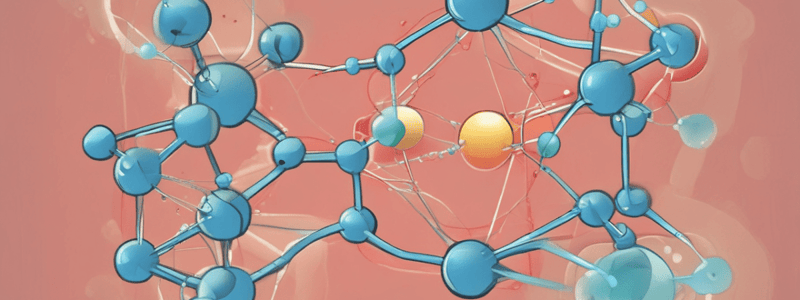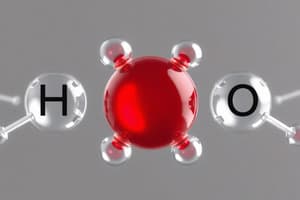Podcast
Questions and Answers
What is the primary driving force behind ionic bonding?
What is the primary driving force behind ionic bonding?
- Electronegativity of the non-metal atom
- The difference in electronegativity between the two bonding atoms (correct)
- The size of the metal atom
- Electronegativity of the metal atom
Which type of atom typically loses one or more electrons to form a cation?
Which type of atom typically loses one or more electrons to form a cation?
- Alkaline earth metal atom
- Non-metal atom
- Noble gas atom
- Metal atom (correct)
What is the arrangement of ions in an ionic compound?
What is the arrangement of ions in an ionic compound?
- Irregular shape
- Random pattern
- Repeating three-dimensional arrangement (correct)
- Repeating two-dimensional pattern
Why do ionic compounds exhibit crystallinity?
Why do ionic compounds exhibit crystallinity?
What is the result of the electrostatic forces between oppositely charged ions in ionic compounds?
What is the result of the electrostatic forces between oppositely charged ions in ionic compounds?
What is the definition of an ionic bond?
What is the definition of an ionic bond?
What is the characteristic of ionic compounds due to the lattice structure?
What is the characteristic of ionic compounds due to the lattice structure?
What is the minimum difference in electronegativity required for ionic bonding to occur?
What is the minimum difference in electronegativity required for ionic bonding to occur?
What type of bond is formed when electrons are transferred from one atom to another?
What type of bond is formed when electrons are transferred from one atom to another?
What is the characteristic of the atom that loses one or more electrons to form a cation?
What is the characteristic of the atom that loses one or more electrons to form a cation?
What is the arrangement of ions in a crystal lattice structure?
What is the arrangement of ions in a crystal lattice structure?
What is the result of the attractive forces between oppositely charged ions in an ionic compound?
What is the result of the attractive forces between oppositely charged ions in an ionic compound?
What is the characteristic of ionic compounds that allows them to be crystalline at room temperature?
What is the characteristic of ionic compounds that allows them to be crystalline at room temperature?
What type of bond is formed when the difference in electronegativity between two atoms exceeds 1.7?
What type of bond is formed when the difference in electronegativity between two atoms exceeds 1.7?
What is the characteristic of the atom that gains one or more electrons to form an anion?
What is the characteristic of the atom that gains one or more electrons to form an anion?
What is the arrangement of sodium ions in a crystal lattice of sodium chloride (NaCl)?
What is the arrangement of sodium ions in a crystal lattice of sodium chloride (NaCl)?
What occurs when the difference in electronegativity between two atoms exceeds 1.7?
What occurs when the difference in electronegativity between two atoms exceeds 1.7?
What is the charge of an ion that forms when an atom gains one or more electrons?
What is the charge of an ion that forms when an atom gains one or more electrons?
What is the characteristic of ionic compounds that allows them to be solid at room temperature?
What is the characteristic of ionic compounds that allows them to be solid at room temperature?
What is the result of the repulsive forces between like-charged ions in an ionic compound?
What is the result of the repulsive forces between like-charged ions in an ionic compound?
What type of arrangement do ions in an ionic compound form?
What type of arrangement do ions in an ionic compound form?
What is the role of electrostatic forces in ionic compounds?
What is the role of electrostatic forces in ionic compounds?
What is characteristic of the atom that loses one or more electrons to form a cation?
What is characteristic of the atom that loses one or more electrons to form a cation?
What is the result of the transfer of electrons between atoms in ionic bonding?
What is the result of the transfer of electrons between atoms in ionic bonding?
What is the primary reason why ionic compounds exhibit a crystal lattice structure?
What is the primary reason why ionic compounds exhibit a crystal lattice structure?
What is the consequence of a large difference in electronegativity between two atoms?
What is the consequence of a large difference in electronegativity between two atoms?
What is the characteristic of the atom that gains one or more electrons to form an anion?
What is the characteristic of the atom that gains one or more electrons to form an anion?
What is the purpose of the crystal lattice structure in ionic compounds?
What is the purpose of the crystal lattice structure in ionic compounds?
What is the role of electrostatic forces in the formation of an ionic bond?
What is the role of electrostatic forces in the formation of an ionic bond?
What is the characteristic of ionic compounds that allows them to be crystalline?
What is the characteristic of ionic compounds that allows them to be crystalline?
What is the result of the transfer of electrons between atoms in ionic bonding?
What is the result of the transfer of electrons between atoms in ionic bonding?
What is the characteristic of the crystal lattice structure of ionic compounds?
What is the characteristic of the crystal lattice structure of ionic compounds?
What is the result of the electrostatic forces between oppositely charged ions in an ionic compound?
What is the result of the electrostatic forces between oppositely charged ions in an ionic compound?
Which of the following is a characteristic of ionic compounds?
Which of the following is a characteristic of ionic compounds?
What is the purpose of the crystal lattice structure in ionic compounds?
What is the purpose of the crystal lattice structure in ionic compounds?
What occurs when an atom loses one or more electrons to form a cation?
What occurs when an atom loses one or more electrons to form a cation?
What is the role of electronegativity in ionic bonding?
What is the role of electronegativity in ionic bonding?




